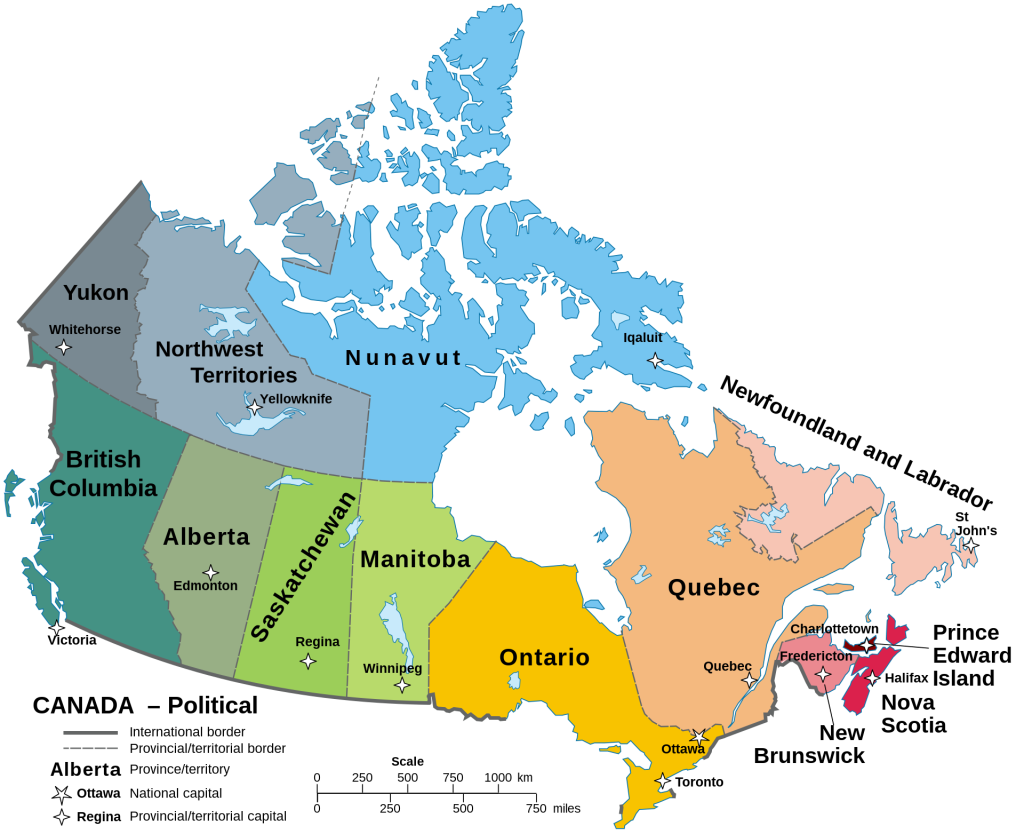Canada is a vast and diverse country known for its stunning natural landscapes, rich resources, and robust political system.
Geography of Canada

a) Size and Borders: Canada is the second-largest country in the world by land area, covering approximately 9.98 million square kilometers. It spans six time zones and is bordered by three oceans: the Atlantic Ocean to the east, the Pacific Ocean to the west, and the Arctic Ocean to the north. It shares land borders with the United States to the south.
b) Provinces and Territories: Canada is divided into ten provinces and three territories. The provinces, from east to west, are Newfoundland and Labrador, Prince Edward Island, Nova Scotia, New Brunswick, Quebec, Ontario, Manitoba, Saskatchewan, Alberta, and British Columbia. The territories, from east to west, are Nunavut, Northwest Territories, and Yukon.
c) Landforms and Natural Features: Canada boasts diverse geographic features, including the Rocky Mountains in the west, the Canadian Shield in the central and eastern regions, the Great Lakes, the St. Lawrence River, the Niagara Falls, the Prairies, the Canadian Arctic Archipelago, and the tundra landscapes of the far north.
Political Map of Canada
a) Provinces: The provinces have their own governments with varying degrees of legislative and executive powers. Each province is further divided into municipalities, which can include cities, towns, and rural areas.
b) Territories: The territories have a more limited degree of self-governance compared to the provinces. They are directly governed by the federal government and have appointed commissioners to oversee their administration.
Political System of Canada
a) Constitutional Monarchy: Canada is a constitutional monarchy, which means it recognizes the British monarch as its ceremonial head of state. Currently, King Charles III is the reigning monarch, represented in Canada by the Governor General at the federal level and by Lieutenant Governors in the provinces.
b) Parliamentary Democracy: Canada follows a parliamentary democracy, combining elements of the British Westminster system with its own unique characteristics. The Parliament of Canada consists of two houses: the House of Commons and the Senate.
c) House of Commons: Members of the House of Commons, known as Members of Parliament (MPs), are elected by Canadian citizens in federal electoral districts or constituencies. The political party with the majority of seats forms the government, led by the Prime Minister.
d) Senate: Senators are appointed by the Governor General on the advice of the Prime Minister. They review and provide sober second thought on legislation proposed by the House of Commons. The Senate acts as a complementary legislative body to the House of Commons.
e) Federalism: Canada operates under a federal system, where powers and responsibilities are shared between the federal government and the provinces/territories. The Constitution Act, 1867, outlines the division of powers, with the federal government overseeing areas such as defense, trade, and international relations, while provinces have jurisdiction over areas like education, healthcare, and natural resources.
f) Indigenous Self-Government: Canada recognizes the rights and self-determination of Indigenous peoples. Through modern treaties, land claims agreements, and other mechanisms, some Indigenous communities have gained a degree of self-government, exercising authority over certain aspects of their territories and governance.
